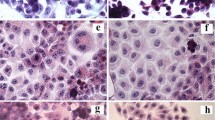Abstract
Two independent dedifferentiated variants, H5 and Faofl C2, derived from the Reuber H35 hepatoma, produce transacting diffusible substance(s) that extinguish the expression of liver-specific proteins when hybridized with a well-differentiated cell line of the same origin (Fao and Fu5-5, respectively). H5 x Fao hybrids show total and stable extinction of four liver functions and clonal variability in the expression of three others. FaoflC2 × Fu5-5 hybrids are initially flat (like FaoflC2 cells), and die in glucose-free medium where survival requires expression of hepatic gluco-neogenic enzymes, but then evolve to hepatoma-like and finally round morphology; these latter cells express all liver functions analyzed including the gluconeogenic enzymes. Two exceptional clones that remained flat long enough for complete analysis showed extinction of all hepatic functions not expressed by FaoflC2 cells. We conclude that this transitory extinction reflects the action and then loss of extinguishing factor(s) contributed by FaoflC2. When crossed with BW1- J mouse hepatoma cells, FaoflC2 causes stable extinction of mouse aldolase B. We propose that production of extinguishing factor(s) is the rule for dedifferentiated variants.
Similar content being viewed by others
Literature cited
Forquignon, F., and Ephrussi, B. (1979).Somat. Cell Genet. 5:409–426.
Deschatrette, J., and Weiss, M. C. (1975).Biochimie 56:1603–1611.
Schimke, R. T., Kaufman, R. J., Alt, F. W., and Kellems, R. F. (1978).Science 202:1051–1055.
Azumi, J. I., and Sachs, L. (1977).Proc. Natl. Acad. Sci. U.S.A. 74:253–257.
Lotem, J., and Sachs, L. (1978).Proc. Natl. Acad. Sci. U.S.A. 75:3781–3785.
Loomis, W. F., Wahrman, J. P., and Luzzati, D. (1973).Proc. Natl. Acad. Sci. U.S.A. 70:425–429.
Eisen, H., Keppel-Ballivet, F., Georgapoulos, C. P., Sassa, S., Granick, J., Pragnell, I., and Ostertag, W. (1978). InDifferentiation of Normal and Neoplastic Hematopoietic Cells. (Cold Spring Harbor Laboratory, Cold Spring Harbor) pp. 277–294.
Reuber, M. D. (1961).J. Natl. Cancer Inst. 26:891–899.
Pitot, J. C., Peraino, C., Moore, P. A., and Potter, V. R. (1964)Natl. Cancer Inst. Monogr. 13:229–246.
Deschatrette, J., and Weiss, M. C. (1975).Somat. Cell Genet. 1:279–292.
Szpirer, C., and Szpirer, J. (1975).Differentiation 4:85–91.
Coon, H. G., and Weiss, M. C. (1969).Proc. Natl. Acad. Sci. U.S.A. 62:852–859.
Ham, R. G. (1965).Proc. Natl. Acad. Sci. U.S.A. 53:288–293.
Bertolotti, R. (1977).Somat. Cell Genet. 3:365–380.
Rothfels, K. H., and Siminovitch, L. (1958).Stain Technol.,33:73–79.
Diamondstone, T. I. (1966).Anal. Biochem. 16:395–401.
Schneider, J. A., and Weiss, M. C. (1971).Proc. Natl. Acad. Sci. U.S.A. 68:127–131.
Sparkes, R. S., and Weiss, M. C. (1973).Proc. Natl. Acad. Sci. U.S.A. 70:377–381.
Segal, H. L., and Matsuzawa, T. (1970). InMethods in Enzymology, (eds.) Colowick, S. P., and Kaplan, N. O. (Academic Press, New York), Vol. XVIIA, pp. 153–159.
Olmo, S., Stenius, C., Christian, L., Harris, C., and Yvey, C. (1970).Biochem. Genet. 4:565–577.
Bertolotti, R., and Weiss, M. C. (1972).Biochimie 54:195–201.
Bertolotti, R., and Weiss, M. C. (1972).J Cell. Physiol. 79:211–223.
Meera Khan P. (1971).Arch. Biochem. Biophys. 145:470–483.
Ballard, B. J., and Hanson, R. W. (1967).Biochem. J. 104:866–871.
Traniello, S., Melloni, E., Pontremoli, S., Sia, C. L., and Horecker, B. L. (1972).Arch. Biochem. Biophys. 149:222–231.
Lane, M. D., Chang, H. C., and Miller R. S. (1969). InMethods in Enzymology. (eds.) Colowick, S. P., and Kaplan, N. O. (Academic Press, New York), Vol. XIII, pp. 270–277.
Lowry, O. H., Rosebrough, N. J., Farr, A. L., and Randall, R. J. (1951)J. Biol. Chem. 193:265–275.
Laurell, C. B. (1966).Anal. Biochem. 15:45–52.
Fougére, C., and Weiss, M. C. (1978).Cell 15:843–854.
Croce, C. M., Litwack, G., and Koprowski, H. (1973).Proc. Natl. Acad. Sci. U.S.A. 70:1268–1272.
Benoff, S., Bruce, S. A., and Skoultchi, A. I. (1978).Proc. Natl. Acad. Sci. U.S.A. 75:4354–4358.
Cassio, D., and Weiss, M. C. (1979).Somat. Cell Genet. 5:719–738.
Author information
Authors and Affiliations
Additional information
Dedicated to our mentor, Boris Ephrussi
Rights and permissions
About this article
Cite this article
Deschatrette, J., Moore, E.E., Dubois, M. et al. Dedifferentiated variants of a rat hepatoma: Analysis by cell hybridization. Somat Cell Mol Genet 5, 697–718 (1979). https://doi.org/10.1007/BF01542636
Received:
Issue Date:
DOI: https://doi.org/10.1007/BF01542636




